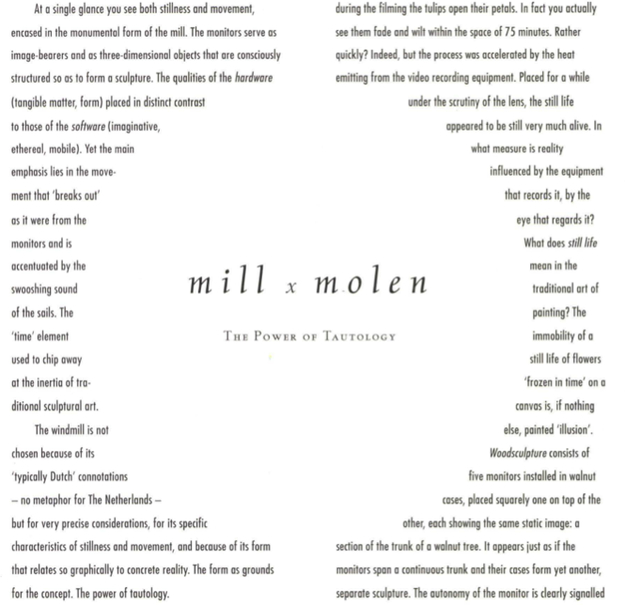Mill x Molen: Twelve large monitors are mounted in the form of the four sails of a windmill at rest (three monitors per sail) - static. The images on all twelve monitors are of windmill sails constantly turning round and round - dynamic. Every screen shows a one-third section of a windmill sail so that each row depicts a complete sail.
The accompanying sound is the forceful, air-slicing rhythmic swoosh of the rotating sails.
At a single glance you see both stillness and movement, encased in the monumental form of the mill. The monitors serve as image-bearers and as three-dimensional objects that are consciously structured so as to form a sculpture. The qualities of the hardware (tangible matter, form) placed in distinct contrast to those of the software (imaginative, ethereal, mobile). Yet the main emphasis lies in the movement that 'breaks out' as it were from the monitors and is accentuated by the swooshing soundof the sails. The 'time' element used to chip awoy at the inertia of traditional sculptural art.
The windmill is not chosen because of its 'typically Dutch' connotations - no metaphor for The Netherlands - but for very precise considerations, for its specific characteristics of stillness and movement, and because of its form that relates so graphically to concrete reolity. The form as grounds for the concept. The power of tautology.
An investigation into stillness and movement, how you can perceive things, how they relate mutually and with reality. An inquiry into the incorporation of meaning and the basics of the video medium - the distancing from reality - with references to traditional disciplines of art. Movement (time), the screen as image- bearer and the monitor, not as 'TV' but as object.
Mill x Molen speaks for itself, but the story becomes even more articulate when you call to mind two earlier installations: Still Life/Slill Alive and Woodsculpture. In Still Life/Still Alive the concept of 'movement' is approached very differently from Mill x Molen: Three monitors placed next to each other each show an image of the same bunch of tulips - again no metaphor for The Netherlands. The tulips were recorded with a video camera for 75 minutes. Each monitor shows a 25-minute sequence in chronological order. And each sequence of the recording is different because during the filming the tulips open their petals. In fact you actually see them fade and wilt within the space of 75 minutes. Rather quickly? Indeed, but the process was accelerated by the heat emitting from the video recording equipment. Placed for a while under the scrutiny of the lens, the still life
appeared to be still very much alive. In what measure is reality influenced by the equipment that records it, by the eye that regards it? What does still life mean in the traditional art of painting? The immobility of a still life of flowers 'frozen in time' on a canvas is, if nothing else, painted 'illusion'. Woodsculpture consists of five monitors installed in walnut cases, placed squarely one on top of the other, each showing the same static image: a section of the trunk of a walnut tree. It appears just as if the monitors span a continuous trunk and their cases form yet another, separate sculpture. The autonomy of the monitor is clearly signalled by the emphatic absence of any moving image. Unmoving or the obsence of movement? Precisely because of the monitors and their screens, that is the first thought that strikes you... (the absence of) movement.
Mill x Molen seems to be a sequel to Woodsculpture, an attempt to distance movement from stillness, as a sort of literal and figurative reminder of the fact that the two concepts cannot either be seen or experienced separately from each other.
Mediamatic Magazine vol 5#1+2 1 Jan 1990
Mill x Molen
The Artists
The Power of Tautology
